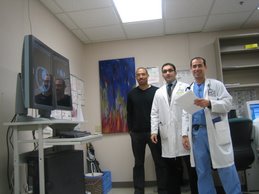Syndrome of continues motor unit activity
Neuromyotonia
Neuromyotonia and myokymia
• The terms “neuromyotonia” and “myokymia” have both been used to describe “clinical phenomena” as well as distinct patterns of abnormal “electrical discharge” recorded during needle electromyography.
Neuromyotonia and myokymia
•This dual nomenclature has created confusion over the years, but no other set of clearer definitions has yet been universally accepted.
Neuromyotonia and myokymia
Both are related clinical phenomena that
result from hyperexcitability of peripheral
nerve motor axons.
Neuromyotonia and myokymia
•Whether they are really separate and distinct clinical entities or just reflect a difference in the severity of the same underlying electrophysiological abnormality remains undetermined.
Neuromyotonia and myokymia
Both may occur in a generalized or focal
fashion and reflect a generalized or
focal alteration in the microenvironment
or membrane of the peripheral nerve.
•Both clinical neuromyotonia and clinical myokymia are also classified as syndromes of continuous motor unit activity.
EMG Characteristics of Neuromyotonia
EMG Characteristics of Neuromyotonia
•Single MUAP firing rapidly
•150 Hz to 300 Hz discharges in long trains
•Trains occur at random intervals
•Train duration up to several seconds
•Decrementing train , Trains start and stop abruptly
•
EMG Characteristics of Myokymia
•Single MUAP firing as bursts of multiplets
•30 Hz to 40 Hz discharges in short bursts
•Burst occur at 2 Hz to 10 Hz
•Burst duration is 100 ms to 900 ms
•Semi-rhythmic burst pattern
•Bursts start and stop abruptly
Neuromyotonia
•is a syndrome marked by prominent and continuous muscle twitching and stiffness
• typically resulting from neuromyotonic and myokymic discharges.
Neuromyotonia
appear in adolescence and adult years. Diagnosis rests on both the clinical manifestations and typical electrophysiologic findings. Features of clinical neuromyotonia include:
Neuromyotonia
•clinical pseudomyotonia (slow muscle relaxation after a forceful contraction)
•contractures of the hands and feet (carpopedal spasms)
•Muscles of the limbs and trunk are stiff and rigid.
Clinical neuromyotonia
•Stiffness is more pronounced in the distal than proximal muscles, and it is worsened by exercise, although it may improve transiently with repetitive movement. Posture may be abnormal with exaggerated kyphosis, and movement is stiff and slow.
•Weight loss is common. The muscles may be well-developed, and sweating may be prominent, possibly because heat is generated by the excessive and constant muscle activity
ptosis, baldness, and temporalis muscle atrophy, cataractsTrinucleotide repeats , CTG .delayed muscle relaxation called myotoniapercussion."dive-bomber" activity that is the EMG hallmark of the disease.
•Dyspnea may result from tightening of the respiratory muscles. Bulbar and laryngeal muscles may be affected. The tongue and jaw become stiff, making swallowing difficult, and the voice turns hoarse
This abnormal activity persists during sleep .
•Focal neuromyotonic syndrome
•Morvan syndrome :
Acompanied with: confusion, insomnia, and hallucinations .
•Ocular neuromyotonia:
Includes intermittent diplopia produced by spasms of the extraocular muscles that occur spontaneously or in response to sustained eccentric gaze.
Physical examination
•Carpopedal spasms with flexion of the wrist, extension of the fingers, and plantar flexion of the feet .
•In clinical neuromyotonia demonstrates normal or depressed tendon reflexes, sometimes with coexisting sensorimotor peripheral neuropathy.
Laboratory studies
May demonstrate serum antibodies to voltage-gated potassium channels as well as mildly increased serum potassium . Oligoclonal bands have been reported in the cerebrospinal fluid .
Etiology
•Clinical neuromyotonia, in most cases, is autoimmune and sporadic .
•Many cases remain idiopathic
•A minority of neuromyotonic syndromes are hereditary and occur with some of the inherited neuropathies ( like the axonal variant of Charcot-Marie-Tooth disease).
•Antivoltage gated potassium channel antibodies are found in 40% to 50% of patients with acquired clinical neuromyotonia .(Vincent 2000; Gutmann 2001a; Van Parijs et al 2002)
•Clear association with thymoma, myasthenia gravis, lung cancer, and neuronal ganglionic antiacetylcholine receptor antibodies. (Vernino et al 1998; Hart et al 2002)
•Clinical neuromyotonia may also appear as a consequence of intoxication with mercury, penicillamine and oxaliplatin.
•Paraneoplastic syndromes of clinical neuromyotonia with hypernephroma and thymoma have also been reported, along with peripheral neuropathy, in bronchogenic carcinoma .
Treatment
•The clinical neuromyotonic syndromes may respond to immunomodulatory treatment including plasmapheresis, intravenous immunoglobulin, and steroids.
Treatment
•Neuromyotonia can sometimes be suppressed with phenytoin, carbamazepine, and dantrolene.
•In some patients, treatment can eventually be discontinued without recurrence , whereas others require life-long therapy.
•Clinical myokymia, in contrast, most commonly occurs as a component of other serious disorders .
•Focal myokymia may be caused by multiple sclerosis, pontine tumors, Guillain-Barré syndrome, radiation plexitis, and, rarely, rattlesnake envenomation. Facial myokymia may also be seen in Bell palsy, syringobulbia, polyradiculoneuropathy, central pontine myelinolysis, tuberculoma, meningeal carcinomatosi, meningeal sarcoidosis, lymphocytic meningoradiculitis, basilar invagination, phosgene poisoning, and hemifacial spasm. Facial myokymia can also occur spontaneously after brain death.
• Limb myokymia occurs in chronic inflammatory demyelinating polyneuropathy, rare compressive neuropathies, syringomyelia, spinal stenosis, conus medullaris teratoma, radiculopathy, neurocysticercosis, subarachnoid hemorrhage, and following cardiopulmonary arrest.
•Generalized myokymia may appear as a part of clinical neuromyotonia, restless leg syndrome, cramp fasciculation syndrome, gluten-sensitive enteropathy, and with clozapine use.
- http://www3.interscience.wiley.com/journal/76507645/home
- http://www.teleemg.com/
- http://www.simulconsult.com/
- http://www.rarediseases.org/
- http://www.neuroland.com/neuro_med/index.htm
- http://www.neuroguide.com/
- http://www.neuro.wustl.edu/neuromuscular/
- http://www.nationalmssociety.org/site/PageServer?pagename=HOM_PRO_professional_education#self
- http://www.merck.com/mmpe/index.html
- http://www.medscape.com/neurology
- http://www.medlink.com
- http://www.mdausa.org/
- http://www.geneclinics.org/
- http://www.familyvillage.wisc.edu/library.htm
- http://www.epocrates.com/
- http://www.emedicine.com/neuro/index.shtml
- http://www.aanem.org/education/podcast/index.cfm
- http://sprojects.mmip.mcgill.ca/neuropath/mainset.htm
- http://neuroexam.com
- http://library.med.utah.edu/pedineurologicexam/html/newborn_n.html#25
- http://icarus.med.utoronto.ca/NeuroExam/main.htm
- http://http://www.urmc.rochester.edu/neuroslides/
- http://clinicaltrials.gov/
- http://brain.oxfordjournals.org/
- http://biochemgen.ucsd.edu/UCSDW3BG/TestChoose.asp
Mar 21, 2007
Subscribe to:
Post Comments (Atom)

No comments:
Post a Comment